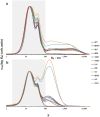The molecular structural features controlling stickiness in cooked rice, a major palatability determinant
- PMID: 28262830
- PMCID: PMC5338010
- DOI: 10.1038/srep43713
The molecular structural features controlling stickiness in cooked rice, a major palatability determinant
Abstract
The stickiness of cooked rice is important for eating quality and consumer acceptance. The first molecular understanding of stickiness is obtained from leaching and molecular structural characteristics during cooking. Starch is a highly branched glucose polymer. We find (i) the molecular size of leached amylopectin is 30 times smaller than that of native amylopectin while (ii) that of leached amylose is 5 times smaller than that of native amylose, (iii) the chain-length distribution (CLD: the number of monomer units in a chain on the branched polymer) of leached amylopectin is similar to native amylopectin while (iv) the CLD of leached amylose is much narrower than that of the native amylose, and (v) mainly amylopectin, not amylose, leaches out of the granule and rice kernel during cooking. Stickiness is found to increase with decreasing amylose content in the whole grain, and, in the leachate, with increasing total amount of amylopectin, the proportion of short amylopectin chains, and amylopectin molecular size. Molecular adhesion mechanisms are put forward to explain this result. This molecular structural mechanism provides a new tool for rice breeders to select cultivars with desirable palatability by quantifying the components and molecular structure of leached starch.
Conflict of interest statement
The authors declare no competing financial interests.
Figures




References
-
- Patindol J., Gu X. & Wang Y. J. Chemometric analysis of cooked rice texture in relation to starch fine structure and leaching characteristics. Starch-Stärke 62, 188–197 (2010).
-
- Li H., Prakash S., Nicholson T. M., Fitzgerald M. A. & Gilbert R. G. Instrumental measurement of cooked rice texture by dynamic rheological testing and its relation to the fine structure of rice starch. Carbohyd. Polym. 146, 253–263 (2016). - PubMed
-
- Cameron D. K. & Wang Y. J. A better understanding of factors that affect the hardness and stickiness of long-grain rice. Cereal Chem. 82, 113–119 (2005).
-
- Li H., Prakash S., Nicholson T. M., Fitzgerald M. A. & Gilbert R. G. The importance of amylose and amylopectin fine structure for textural properties of cooked rice grains. Food Chem. 196, 702–711 (2016). - PubMed
Publication types
MeSH terms
Substances
LinkOut - more resources
Full Text Sources
Other Literature Sources

